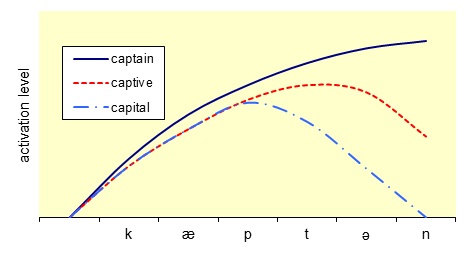
Frequency effects in word recognition
Words that we encounter more often have an advantage over words that we do not see or hear so often. This is reflected in faster response times and greater accuracy for common words in tasks such as lexical decision. In the figure below, levels of activation of word candidates are shown on the vertical axis, and the segments in a word being heard (the word captain, here shown in phonetic symbols) are shown left-to-right on the horizontal axis. As the sequence of segments is heard, the frequency effect is shown by a slower increase in activation for captive and capital relative to captain, so that even when the phonetic information still matches both captain and captive (e.g. at /kæpt/), the former already shows an activation advantage. (See further chapters 8 and 9 in Introducing Psycholinguistics, esp. pages 132 and following.)
